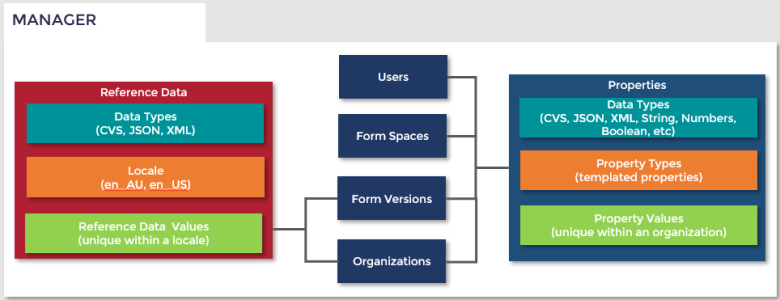Properties Overview
Journey Manager (JM) The transaction engine for the platform. | System Manager / DevOps | All versions This feature is related to all versions.
Journey Manager provides various properties allowing you to customize many parts of application forms without the need to rebuild them. This gives a great flexibility in adjusting user journeys. Properties are based on property types defined for all entities of a certain scope, which can then be assigned a value for each entity. A scope of a property can be one of the following:
- Client: a property configured for an organization and its forms, so it obtains its value dynamically from an organization.
- Form: a property configured for form versions, so it obtains its value directly or dynamically from a form version. This property can override Client's scope property.
- User: a property configured for user profiles, so it obtains the value from a user’s profile of a logged user.
You must have the Administrator role to be able to create a new property type.
You can use properties in:
- Prefill of data in a form
- Form branding
- Links to related resources
- Standard emails
- Help text
The diagram below shows relationship between properties and other entities within Manager.

You can also use reference data in your applications depending on requirements.
Manager distinguishes between the following properties:
| Defined at | Relates to | Property Scope |
|---|---|---|
|
System |
||
|
Module specific |
||
|
User experience – form |
||
|
User experience – form |
Client |
|
|
User experience – form |
Form |
|
|
User experience – form (collaboration job) |
||
|
User experience – user profile |
User |
Within Manager, properties can be defined across multiple levels, such as a form space that hosts an organization’s forms. This multi-level configuration approach gives you additional control and flexibility. Properties can have default values set at the higher levels, which can be overridden at each lower level. That is, for form-related properties where an organization property setting exists, it takes precedence over the related form space property setting, and where a form version property setting exists, it takes precedence over the related organization and form space default settings for this property.
For instance, a property could be the message of a status email sent to a user of a form. This is defined for a form space. Whenever this status email is sent out to a user who has submitted a form hosted on this form space, the status email uses the property defined at the form space. However, if a different status email is required to be sent to users of forms of your organization, then you would need to add and configure the status email specific to your organization.
Out-of-the-box, Manager comes with a standard set of properties with preset values for each form space. However, you can configure a different value at any level, such as a form, form space, organization or global, which overrides the standard value.
Manager allows you to view existing property types, create new ones and remove ones you don't need anymore.
Next, learn how to view properties.